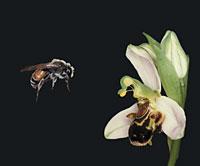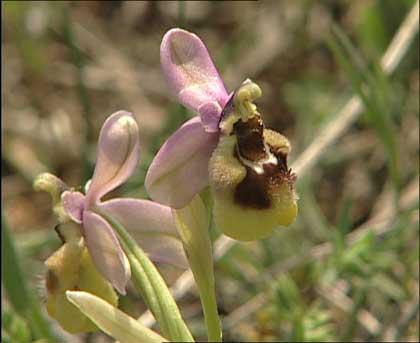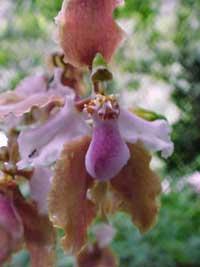Pyrenees in bloom in five colours
2008/07/01 Galarraga Aiestaran, Ana - Elhuyar Zientzia Iturria: Elhuyar aldizkaria

The alternation of flowers is not only a whim of nature, since plants adapt to the climate and the climate changes a lot with height. The higher the colder it does, so the flowering is delayed in the high mountains. Approximately, for every two hundred meters rising, the temperature drops one degree. In addition, the intensity of the incoming ultraviolet radiation, the risk of snow and the strength of the wind increase with the height and the soil is impoverished.
In addition to the heights, other climate-related factors influence its flowering: the orientation to the sun, that is, if the place is sunny or gloomy; the proximity or remoteness of the sea; the presence of torrents, streams or rivers in its surroundings; the phenomenon of thermal investment...

Since the conditions change so much according to the place, it is not surprising that in the Pyrenees the floral variety is so large. South-South and Eastern Pyrenees have Mediterranean characteristics, while the Atlantic has North-Western emissions. Finally, the high mountains are considered boreoalpes, as they have characteristics of the Alps and the northern latitudes. Thus, according to IUCN (International Union for Conservation of Nature) and WWF, it is one of the most biodiverse places in the world, superior to the Alps, for example.
Thus, approximately 3,500 species have been identified, of which 180 are endemic, that is, only live in the Pyrenees. Some also extend to western mountain ranges, so they are Pyrene-Cantabrian endemism. Examples of this are the species Iris latifolia, Aquilegia pyrenaica and Lilium pyrenaicum.
This wealth is due to the geographical location of the mountain range, its orography and its geological history. For example, there are some Tertiary flowers. They are very special, since at that time the European climate was tropical. Changing the climate, most of the plants of the time disappeared, but in the Pyrenees some have survived, among others, the unique Borderea pyrenaica.
However, the alternation of the glacial and interglacial phases of the Quaternary has most influenced the flowers of the Pyrenees. The mountain range is an authentic wall between the peninsula and the continent, with the consequent loss of species. But the ice retreat helped the flora migrate from north to south and from south to north.
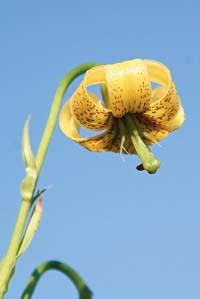
For example, during the glaciation, the flora of the northern latitudes extended to the south, which has allowed boreal plants to exist in the Pyrenees, such as the herbaceous Salix. In the interglacial phase, migrations also occurred in a transversal sense. Thus, in southern Asia, crossing the Carpathians and the Alps, came plants like the Leontopodium alpinum. It is a symbol of the high mountains, not called in vain the snow flower. This white flower is covered with hairs that protect it from ultraviolet radiation and frost, allowing it to bloom also in peaks of more than 3,000 meters.
It is clear that environmental factors (climate, irradiation...) have a great influence on the Pyrenean flora. But human pressure is not negligible either. In fact, the function of flowers is, in general, to attract insects, since with their help the vegetation has more possibilities of reproduction. However, in addition to insects, the flower attracts people, and due to excess collection and direct or indirect damage caused by other activities, some plants are in danger of extinction.
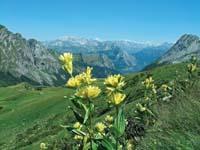
One of them is the Cypripedium calceolus. It is an orchid with a flower with a petal at the bottom, intense yellow, with two purple and pouch-shaped spots. Da and is an insect trap, the only European orchid that has a label that works as a trap. Insects enter the label attracted by the appearance and there they are forced to pass through a channel. At the entrance of the channel they leave the pollen that they can bring from another flower and when they leave they stick the pollen of that flower. Then, they can take the pollen to another flower.
This form of reproduction is very specialized and singular, so it is a flower of high value. In addition, it is not widespread: It can be found in North America, Europe and Asia, but is being lost in many places. For example, in Belgium and Luxembourg it has disappeared and in Britain only a few wild specimens remain. In the Pyrenees, it is only located in a few places of 1,200-1,600 meters high, in the countryside, in the beech or in some forest by the river.
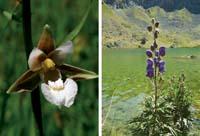
Now in danger of extinction. According to the catalogue of the Spanish Ministry of Environment, with respect to the data of the nineteenth century, the loss is very accused and is in a critical situation. In fact, the populations are isolated and there are not too many specimens in each of them. The main causes of loss are concentration, livestock pressure, habitat alteration and infrastructure construction.
Spanish and French officials have already implemented protection and recovery measures, both in Spain and France. But Cypripedium calceolus is not the only plant in danger. In the past, human activities, especially livestock, have put strong pressure on the Pyrenean flora. Although many of these activities are currently in decline, new ones have emerged: tourism, reservoirs, skiing, urbanizations, car parks and roads... All of them are causing the disappearance of plants and their habitats.
In addition to all this, climate change has also raised concern among scientists. Biologist José Luis Benito, an expert in the flora of the Pyrenees, has shown that some flowers now come out over a hundred years. This may be due to an increase in temperature and, according to him, may follow the trend, "but it is clear that when they reach the top they will not be able to climb more".

Gai honi buruzko eduki gehiago
Elhuyarrek garatutako teknologia



